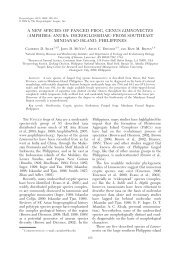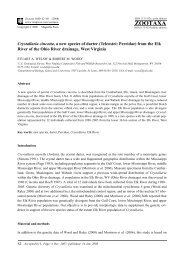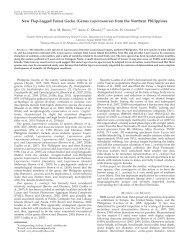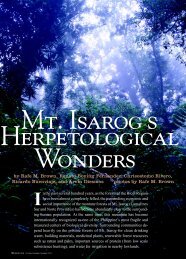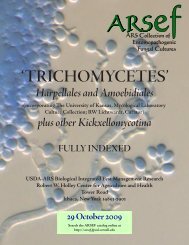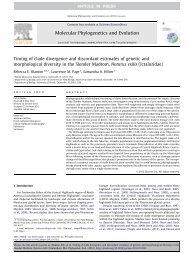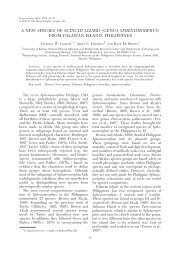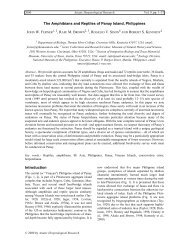(Percidae: Etheostoma), with Descriptions of Five New Species
(Percidae: Etheostoma), with Descriptions of Five New Species
(Percidae: Etheostoma), with Descriptions of Five New Species
- No tags were found...
You also want an ePaper? Increase the reach of your titles
YUMPU automatically turns print PDFs into web optimized ePapers that Google loves.
Layman & Mayden Morphological Diversity and Phylogenetics <strong>of</strong> the Darter subgenus Doration (<strong>Percidae</strong>: <strong>Etheostoma</strong>) 17tion and plate; Virginia distribution); Etnier and Starnes,1994:534–537 (biology; distribution and status; systematics;key); Jenkins and Burkhead, 1994: 838–840, fish 290–291, plate 28 (systematics; description; breeding malecoloration; biology; habitat; distribution; halftone photos;breeding male color plate).<strong>Etheostoma</strong> meadiae (Jordan and Evermann) was resurrectedby Howell (1980b), who found the name availablefor a distinctive form <strong>of</strong> Doration from the upper Clinchand Powell rivers in the upper Tennessee drainage.Howell (1968) had earlier treated these populations asintergrades between what he considered nominal E. stigmaeumfrom the Cumberland drainage (described as anew species below) and nominal E. jessiae. He based thisassessment on the observation that 53% <strong>of</strong> specimenspossessed a frenum, which he considered the most distinctivecharacter separating the taxa, and present-daydrainage patterns suggestive <strong>of</strong> stream capture betweenthe Cumberland and Powell rivers.Examination <strong>of</strong> additional specimens later convincedHowell (1980b) that these apparent intergrades actuallyrepresent a distinct taxon (Etnier and Starnes, 1994). Hisrecognition <strong>of</strong> E. meadiae and all other taxa <strong>of</strong> Doration asdistinct species (Howell, 1980a, 1980b, 1980c) was bolsteredby the apparent reproductive isolation <strong>of</strong> sympatricforms <strong>of</strong> E. stigmaeum and E. jessiae in the Stones River<strong>of</strong> the Cumberland drainage (Etnier and Starnes, 1994,in pers. comm. <strong>with</strong> Howell). Howell’s (1980a, 1980b,1980c) conclusions were not accompanied by supportingdata. Consequently, E. meadiae has failed to gain recognitionas a species. Furthermore, the single record <strong>of</strong> E. jessiaefrom the Stones River has been shown to be invalid,having resulted from an error in cataloging specimensfrom Little Pigeon River in the Tennessee River drainage(Layman, 1994).<strong>Etheostoma</strong> meadiae is currently treated as a subspeciesor race <strong>of</strong> a polytypic E. stigmaeum by Etnier andStarnes (1994). Jenkins and Burkhead (1994) also treatit as a subspecies but hold out the possibility <strong>of</strong> it beingan intergrade. Starnes and Etnier (1986) pointed to thelack <strong>of</strong> evidence for a major stream capture between theCumberland and Powell rivers, weakening support forHowell’s intergradation hypothesis (Etnier and Starnes,1994). Patterns <strong>of</strong> nuptial male coloration are also inconsistent<strong>with</strong> intergradation. Males <strong>of</strong> both supposed parentaltaxa develop orange pigment in the base <strong>of</strong> thespinous dorsal fin and bright orange spots on the s<strong>of</strong>tdorsal, caudal, and pectoral fins. These features are lackingin E. meadiae.Morphological and breeding color data gathered inthis study indicate that E. meadiae warrants recognitionas a distinct species. Moreover, the phylogenetic hypothesisgenerated using these data suggests that E. meadiaeand E. jessiae are not even sister taxa. <strong>Etheostoma</strong> meadiae istreated herein as a distinct species restricted to the upperClinch and Powell rivers upstream <strong>of</strong> Norris Reservoir inTennessee and Virginia.Holotype.—USNM 48903, male, 46 mm SL, IndianCreek, tributary <strong>of</strong> Powell River, Cumberland Gap, Tennessee,17 October 1893, R. R. Gurley. The holotype isfigured in Jordan and Evermann (1900:fig. 447).Paratypes.—USNM 125623, male, 46 mm SL, samedata as holotype, original number BF 711 (U. S. Bureau<strong>of</strong> Fisheries). According to Collette and Knapp (1966),the third type was apparently sent to Stanford University,but it was not listed among the types there by Bohlke(1953); they were unable to locate it.Figure 8. <strong>Etheostoma</strong> meadiae (Jordan and Evermann, 1898). Blackwater Creek at TN Hwy 70, 0.5 km S Virginia line,Hancock County, Tennessee, 1 April 1993. UAIC 10706.01; male, 51 mm SL. Drawing by Joseph R. Tomelleri (americanfishes.com).Copyrighted by Joseph R. Tomelleri. Used <strong>with</strong> permission.



